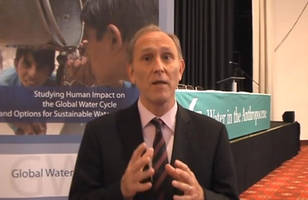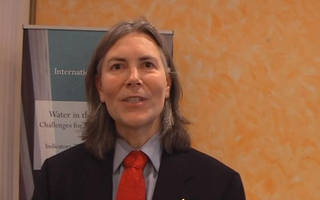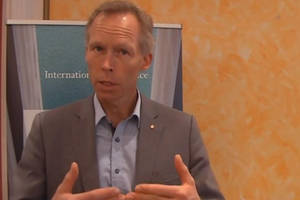“Water in the Anthropocene: Challenges for Science and Governance,” 21 – 24 May 2013, Bonn, Germany
Interview with Joseph Alcamo, UNEP, Nairobi, Kenya

Question:
Can conferences like this help to convey messages from the scientific community to policy makers?
Response:
For sure it can. If we manage to distill down the big messages coming from this conference into some clear messages, which is not always easy for scientists. On the other hand it would be even better, if we invite the policy makers to these conferences, that we can actually have a face to face dialogue with them.
Question:
What is the role of water research in the upcoming initiative “Future Earth?”
Response:
Future Earth is a very exciting development on behalf of the science community, in which the global change research organisation are now re-organising themselves to make themselves more policy relevant. Water has to play an important role in there. If you would have asked me which topic should be on top of the agenda I would say Global Water Research as part of Future Earth needs to address development issues, because we still have the situation where 20 % of the world is holding 75 % of the world’s riches. And I think those other 80 %, and they for sure think so, that they deserve their part of the world’s riches. So I think a huge task for the science community has to work with that 80 % and show them how can they get their fair share of water and not destroy the global water system.
Interview with James Syvitzki from the University of Colorado Boulder, USA

Question:
What is the role of water in the Anthropocene?
Response:
The Anthropocene is a measure of the permanent record of the footprint of humanity. If somebody came to Earth from another planet a million years from now would they see evidence of humanity, and is it big enough to be equivalent to how the ice ages changed the landscape, as an example? That is the concept of the Anthropocene. The role of water in it is that humans have been manipulating the water flows. One of the footprints of humanity is how we have changed the river systems, how we created lakes; we call them reservoirs behind dams. But we have done this all over the world. We have done it to such an extent that we have build one large dam every day for the last 132 years. We are changing where rivers flow, many rivers no longer flow to the coastal ocean, we use the water for irrigation and it goes up into the sky and rains on the ocean. We have changed the hydrological cycle and that is an example of how humanity’s footprint is showing up in the water flows.
Question:
How can science contribute to a more sustainable water use?
Response:
Science is the backbone of how we learn about physics and how physics and biology manifests itself on the planet. We need a good fundamental understanding of the water cycle and how the water cycle interacts with the species called humans and how humanity is changing that cycle. In terms of sustainability we are able to make adequate measurements from space , we are able to make adequate ground base measurements. And all of this with a good fundamental background in science allows us to make useful decisions for whether we are overusing water, whether the quality of water is good or not and whether we are doing something that could be harmful on the long run such as pump too much water out of the ground from the groundwater supplies at a rate that cannot be replaced say by rainfall. All of this is science based and you need good grounding in science to do sustainable science.
Question:
Why are deltas so important in the Anthropocene?
Response:
Deltas are to some extent – not completely- a byproduct of humanity in the first place. We have cut forest down, we have done huge amounts of mining in the hinterlands. All of this has moved a lot of sediment from the uplands to the low lands and these deltas have grown. They are very flat, they are very fertile, we grow crops there. Because of that a lot of people like living there close by the sea. We have right now at least half a billion people live on deltas. Unfortunately these deltas are sinking four times faster than sea level is rising, because of subsidence: We are mining water, gas, oil from the deposits that the deltas are consisting of and that causes these flatlands to be lowered. There is now a problem between humanity wanting to live there and making use of them (i.e. shrimp farms). Basically there are going to disappear in the next one hundred years. That is a problem, a migratory problem. Where are these people going to live when deltas are below water?
Question:
How can science-based information transform into policy action?
Response:
Policies are the ideas that at their very basics, taken into account governance, cultures, how we interact with each other, how rich people interact with poor people, how one country interacts with another country. Water at the very basis is one of these cross- cultural, cross- boundary issues. To make good water policy decisions we really need to understand our civil society. Science can play a very important role in making sure that we do not recommend something that will ultimately provide a very positive benefit to one part of our society or country and not to another. I think that science can definitely inform policy and it should inform policy and it should be a political.
Interview with Johan Rockström from the Stockholm Resilience Center, Stockholm, Sweden

Question:
Why do you think politicians will follow the advice of scientists when it comes to planetary boundaries?
Response:
The science of planetary boundaries, which defines a safe operating space for humanity in the Anthropocene, has an opportunity to be picked up by policy, society and business for the three following reasons: The first one is that we are starting to see more and more empirical evidence that we are about to hit the ceiling the planet can cope with, we are starting to see real impacts on the economy today, which is understood. The second issue, which is interesting, we are starting to focus on benefits of action rather than the big costs of protecting the environment. We are starting to understand that the biosphere, the environment at large from freshwater to biodiversity, is actually the basis for our economy, and that good business good development, good welfare originates from a very wise stewardship of the biosphere. The third reason is that we are living in an era where everyone understands that we are in the globalised phase of the economy, the globalised phase of communication and increased understanding has developed that we are in the globalised phase of environmental implications. The whole notion of the Anthropocene is sinking in. And once you are in a globaliz for global partnerships, what we call planetary stewardship. But of course we are not there yet. But at least there is the trend towards this direction. One example is that the United Nations work on going from the Millennium Development Goals to the Sustainable Development Goals, where there is a genuine discussion on setting global sustainability criteria including freshwater within which you can have growth and prosperity. This is a totally new discourse compared to the old discourse, which has been growth and development while reducing environmental impacts as far as we can.
Question:
How can local improvements lead to positive change on a global scale?
Response:
The local-global interactions are today at the heart of necessary focus and solution. Up until recently we have been mostly preoccupied by investing in local improvements of freshwater use, of agricultural productivity, energy supply etc. We have not had to consider the fact that the global scale is now impacting on the local scale. We have now come to a point where global drivers of change, climate change affecting freshwater supply, affect the local scale. Now suddenly global sustainability is a prerequisite even for a farmer’s livelihood in Burkina Faso or the economic development in a country anywhere in Europe. The global hits the local, but of course the trick is that success at the local scale has to add up to meeting at the global scale. We now have come to a point where you need to have innovations at the local scale, scaling up and aggregating to positive change at the global scale. We do not have any good examples of that so far, this is the dilemma we are facing. Despite success on islands the curves are still moving in the wrong direction at the global scale. My conclusion is that we need much more global leadership. We need to have a political leadership that regulates the playing field by putting a carbon tax in place, a clear restriction on how we expand agriculture in the world, a clear restriction how we use freshwater, not as a way of putting hold on development but to create a space for growth and development. It is this magic of linking local innovation and growth with policy and support which can guide a transition to a more safe and desired future. This is often considered as utopia but I often try to remind everyone that we do that for example in global trade. We have mechanisms to work together as a global community when we have risks which we cannot accept. But for some reason when it comes to the environment it is always considered as being more or less impossible to solve at the global scale. There is an interesting opportunity to learn from other sectors in terms of now joining forces how to get to local improvements through global collaboration.
Question:
What does it mean if the tipping point for freshwater is reached?
Response:
We concluded that freshwater use is one of the nine planetary boundaries. Why is it one of the planetary boundaries? Well, this is because freshwater is, to put it simple, the bloodstream of the biosphere. It is the factor that determines the resilience of the entire terrestrial ecosystems, it is behind all biomass growth, it is behind all biodiversity, it is behind all agriculture in the world, and therefore it is the regulating factor behind carbon sinks, nitrogen flows, phosphorous flows, so it is the very mechanism behind the scenes under the hood of the earth system machinery to regulate the stability of the earth system. We concluded that you can empty your rivers in the world to a certain point beyond which you may start seeing threshold effects in terms of that regulatory capacity. We concluded that the boundary for that is in the order of 4000 km³ per year of maximum consumptive use. We are today using almost 3000 km³, so we are withdrawing much more, in the order of 6000 km³, but we are only consuming 3000 km³ as some of it flows through agricultural systems etc.. So we have some degrees of freedom at the global scale but we are rapidly moving towards the ceiling because we know that just to feed a world of 9 billion people will exceed the boundary. It is an interesting time right now: it is not as if we have pushed water so far that we are in a global crisis, but we are certainly heading in the wrong direction and we have hotspots in the world where things are already in the red, so to say. The solution must be to be much more clever in terms of productive water use, basically to produce more human well being per drop of water. There is an enormous potential in using rainfall much smarter. In the end remember that it is only 10 – 20% of the rainfall which becomes runoff, 80% infiltrates in the soil and becomes green water which evaporates back to the atmosphere. This enormous amount of water can be used much more cleverly. We can manage our landscapes in ways that it maintains particular diversity of ecosystems which are not just there for the sake of preserving species, but for the sake of having much better flow of water through landscapes and therefore a much more stable supply and a much more resilient supply so you can avoid shockwaves of floods, for example, when we have straightened out rivers to much but instead having meandering systems. It is the question of getting a much more clever, integrated stewardship for productive water use and for securing rainfall in the future. Then of course, we need to collaborate again as nations in the world. We have regions in the world that grow so fast and have so little water that their only solution for the future will be through virtual water trade; it will be through collaborative trading of freshwater via food produced in other parts of the world. So again, we need democracy and stability in the world to operate in order to share the finite freshwater we have. To conclude, the growth of demand of freshwater is tremendous, it is growing exponentially and will continue to grow exponentially as the world becomes richer and more populous but still the conclusion is: we can solve it. It is interesting that we have so much technology and so many management impacts and so much untapped potential. There is no scientific evidence that will suggest that we cannot sustain to feed a world population of 9 billion people, for example. I am emphasizing food because 90% of your and my freshwater need is for food after all, so this is the bulk of the freshwater we are using. 3000 – 4000 liter per person per day is for our diet. This is a challenge but also an area where we can move quite successfully into the future.